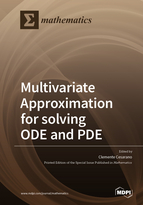Multivariate Approximation for solving ODE and PDE
A special issue of Mathematics (ISSN 2227-7390). This special issue belongs to the section "Difference and Differential Equations".
Deadline for manuscript submissions: closed (31 March 2020) | Viewed by 24107
Special Issue Editor
Interests: special functions; orthogonal polynomials; differential equations; operator theory; multivariate approximation theory; Lie algebra
Special Issues, Collections and Topics in MDPI journals
Special Issue Information
Dear Colleagues,
Multivariate approximation is an extension of approximation theory and approximation algorithms. In general, approximations can be provided via interpolation, as approximation/polynomials interpolation and approximation/interpolation with radial basis functions or, more in general, with kernel functions. In this Special Issue, we would like to cover the field of spectral problems, exponential integrators for ODE systems, and some applications for the numerical solution of evolutionary PDE, also discretized, by using the concepts and the related formalism of special functions and orthogonal polynomials, which represent a powerful tool to simplify computation. Since the theory of multivariate approximation meets different branches of mathematics and is applied in various areas such as physics, engineering, and computational mechanics, this Special Issue is open to a large community of researchers.
Prof. Clemente Cesarano
Guest Editor
Manuscript Submission Information
Manuscripts should be submitted online at www.mdpi.com by registering and logging in to this website. Once you are registered, click here to go to the submission form. Manuscripts can be submitted until the deadline. All submissions that pass pre-check are peer-reviewed. Accepted papers will be published continuously in the journal (as soon as accepted) and will be listed together on the special issue website. Research articles, review articles as well as short communications are invited. For planned papers, a title and short abstract (about 100 words) can be sent to the Editorial Office for announcement on this website.
Submitted manuscripts should not have been published previously, nor be under consideration for publication elsewhere (except conference proceedings papers). All manuscripts are thoroughly refereed through a single-blind peer-review process. A guide for authors and other relevant information for submission of manuscripts is available on the Instructions for Authors page. Mathematics is an international peer-reviewed open access semimonthly journal published by MDPI.
Please visit the Instructions for Authors page before submitting a manuscript. The Article Processing Charge (APC) for publication in this open access journal is 2600 CHF (Swiss Francs). Submitted papers should be well formatted and use good English. Authors may use MDPI's English editing service prior to publication or during author revisions.
Keywords
- Numerical methods
- Approximation theory
- Polynomial interpolation
- Spectral problems
- Evolution operators
- ODE
- PDE






